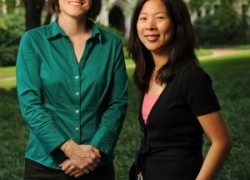
Short, flimsy, and gaudy, the political yard sign is a fixture of any American election, loudly proclaiming the political affiliation of a homeowner. But are these tiny signs serving another purpose? Are they actually getting inside our subconscious and changing the outcome of our elections?
Two political scientists at Vanderbilt University think they know. Cindy Kam and Elizabeth Zechmeister tested the effects of name recognition using carefully controlled experiments, an unusual but growing practice among political scientists. In the lab, the pair learned that voters are more likely to support one unknown candidate over another if they catch a glimpse of that candidate’s name. Further experiments in the field showed that voters who were exposed to a candidate’s yard signs showed greater support for that candidate. This link between name recognition and candidate support in low-information races could change the way voters and candidates behave in local elections.
Kam and Zechmeister have shown, in a paper currently under consideration for publication, that brief exposure to a candidate’s name increases voter support by 13%, if voters know nothing else about the candidates. Using a political science lab at Vanderbilt University, the two researchers were able to test almost five hundred subjects, split into two groups. One group was subliminally exposed to a candidate’s name, while the other was shown an identical questionnaire, but flashed only random letters in place of a name. The controlled setting allowed the researchers to keep every aspect of the experiment consistent, varying only whether subjects were exposed to the name, thus proving that name recognition caused the increase in support. However, the Vanderbilt team wanted to see if their results translated to the real world. In cooperation with a local school, they posted yard signs along a road travelled by half of all parents to reach the school. When surveyed, parents using that road were 10% more likely than others to vote for the candidate named on the yard signs. While this field experiment lacked some of the accuracy of the lab tests, it demonstrated a real world link between name recognition and candidate support.
This link holds implications for local elections in which voters know nothing about the candidates involved. Campaign staffers can gain a simple advantage by investing in signs and ads to spread their candidate’s name. Voters can learn to recognize situations in which their decisions could be unknowingly affected by name recognition. As Zechmeister explains, “our research tries to get voters or potential voters to stop and think about the process that they undergo when they step into the voting booth.”
The experimental methods employed by Kam and Zechmeister represent an nontraditional, but increasingly popular, approach to political science research. As Kam notes, for much of the twentieth century, political scientists focused on case studies to learn more about political processes. Only in the last two decades, as computers enabled political scientists to collect data in larger, more accurate sets, did experimental research become prevalent. In the Research on Individuals, Politics, and Society (or RIPS) lab, where Kam and Zechmeister conduct their research, fourteen computers line the walls of two nondescript rooms. Using these computers, researchers at Vanderbilt can pose very specific questions to subjects, while carefully controlling the information those subjects receive. Sohee Park, a research psychologist who has collaborated with Cindy Kam on past studies, see parallels between this design and those employed in psychological research. “We use exactly the same methodology, with some small differences… I think of Cindy as a social psychologist in disguise.”
Today, the RIPS lab, founded in 2008, is one of an estimated thirty such labs in the United States. That number is growing. In a recent study, Jamie Druckman, a political scientist at Northwestern University, found that the number of experimental political studies published each year has doubled since the late 1980s. Zechmeister agrees, noting that “when you put a lab in a political science department, like we have at Vanderbilt, you find that more and more people start to use it.”
Yet, experimental research is not appropriate for all types of political science. “Real politics are more complex. A major challenge for the field in future years is to design experiments that clarify political phenomena in more dynamic, and arguably realistic, ways,” explains Druckman. Additionally, as Donald Green of Columbia University points out, experimental methods cannot answer questions such as “what is the best form of government?” or “is obesity on the rise?” Kam acknowledges that the nature of her field will always create challenges. “We’re not a hard science in that we deal with people, and in fact, that’s harder because people are more unpredictable.”
